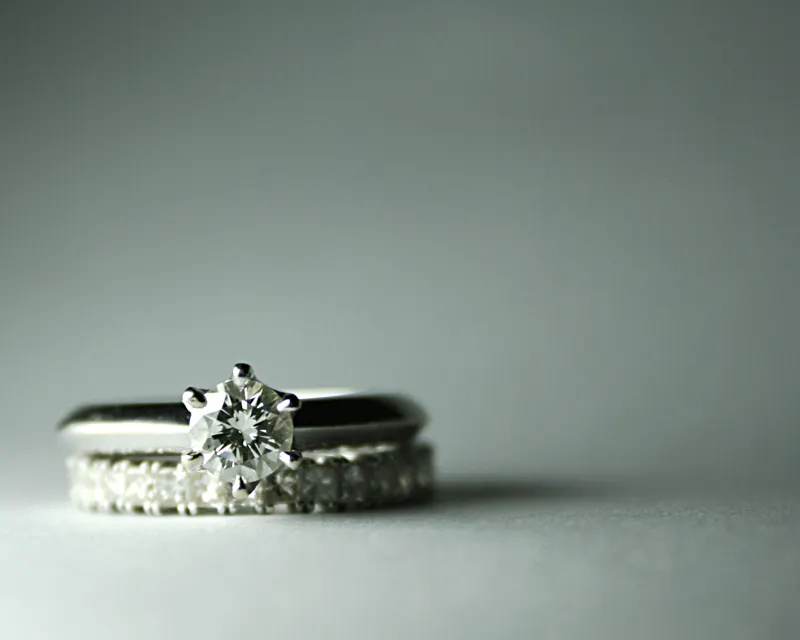Diamond Polish and Symmetry Explained
If you're a first-time buyer, you may be worried about diamond polish and symmetry grades. But what do these grades mean, and do they impact price?
3 Minute Read
What do Diamond Polish Grades Mean?
It's rare for a diamond to have a perfect polish. More often, they have tiny imperfections not visible to the naked eye. These can be pits, abrasions, nicks, scratches, and burn marks.
Gemological laboratories grade polish as "Poor," "Fair," "Good," "Very Good," and "Excellent." Avoid grades of "Poor," since a polish like that will negatively impact a diamond's beauty. However, grades of "Fair" could work for smaller stones under 0.70 cts.
A diamond polish grade of "Good" or better is enough that your eye will never pick out any polish imperfections. These can only be seen through a jeweler's loupe.
If you have a diamond with "Poor" or "Fair" polish, consider getting it re-polished. Although the diamond will lose some weight, it will look better. However, if it drops below a benchmark carat weight, like the 1-ct mark, re-polishing could leave the stone significantly less valuable.
What do Diamond Symmetry Grades Mean?
Unlike polish, diamond symmetry isn't exactly what it sounds like. While most people would expect symmetry to refer to the stone's shape, it actually refers to how well-aligned the diamond's facets are.
Like diamond polish, gemological laboratories grade diamond symmetry as "Poor," "Fair," "Good," "Very Good," and "Excellent." Again, similar to diamond polish, a grade of "Poor" means the facet alignment is so inferior it has impaired the diamond's appearance. Even a novice buyer would easily see problems with such a stone. While certainly better, a diamond with a symmetry grade of "Fair" won't return light as well as a diamond with better symmetry.
So, as with diamond polish, it's best to stick to grades of "Good" or better. Without a loupe and years of experience, you'll never know the difference between "Good" and "Excellent."
Do Diamond Polish and Symmetry Impact Price?
Of course, the big question for consumers is whether you can save by choosing a lower grade for polish and symmetry. The answer: not really.
Because of the high demand for "Excellent" diamond polish and symmetry grades, there are few diamonds with "Excellent" cut grades and lower grades for either polish or symmetry.
So, there are few diamonds that have "Excellent" cut parameters with even a "Very Good" rating for polish or symmetry. If you compare stones with "Excellent" cut, polish, and symmetry grades to those with "Excellent" cut grades but "Very Good" polish and symmetry, you might save a few hundred bucks by going with the lower grades.
For example, look at these 0.8-ct diamonds from James Allen. Both are I color, SI1 diamonds. Both have "Excellent" cuts and performance. The one with "Excellent" polish and symmetry is modestly more expensive, at $2,760, compared to the one with "Very Good" polish and symmetry, at $2,590.
In the end, it's not worth it to specifically seek out lower grades for these factors, since they'll only give you a modest reduction in price compared to choosing a lower color or clarity grade, or even a fluorescent diamond. However, there's also no reason to omit these diamonds from your search results.
Where Should I Buy a Diamond?
The best place to shop for a diamond ring is in your living room. While brick-and-mortar stores make it a little easier to see the diamond's performance, they have limited inventories compared to online retailers. These stores also have additional operating expenses that their online competitors don't. This means that online vendors can offer their diamonds for less and give you a greater selection.
When buying online, be sure to use a trusted jeweler with magnified video of the diamond you're buying. This is essential for seeing clarity imperfections and how well the diamond performs. You'll also be able to see polish imperfections in a diamond with a lower polish grade.
Both James Allen and Blue Nile offer magnified, 360° videos of their diamonds. However, James Allen also has experts who can review the diamond with you. Furthermore, they have a larger selection of ring styles — essential for choosing the perfect engagement ring.
If you're still not confident that you're getting a good deal, or just can't seem to find the ring that fits your personality, consider working with the experts at CustomMade. Their experienced jewelers will help you create the perfect engagement ring with a diamond you'll cherish.
Addison Rice
A geologist, environmental engineer and Caltech graduate, Addison’s interest in the mesmerizing and beautiful results of earth’s geological processes began in her elementary school’s environmental club. When she isn’t writing about gems and minerals, Addison spends winters studying ancient climates in Iceland and summers hiking the Colorado Rockies.
Related Articles
Diamond Value, Price, and Jewelry Information
HPHT Diamond Treatments
Oval Cut Diamond Buying Guide
Understanding Gem Synthetics, Treatments, And Imitations, Part 3: Synthetic Diamond
Latest Articles
800 Years of Mogok: A Celebration in Tenuous Times
What is the Average Gemstone Faceting Yield?
Pyroxmangite Value, Price, and Jewelry Information
How to Identify Emerald Simulants and Synthetics
Never Stop Learning
When you join the IGS community, you get trusted diamond & gemstone information when you need it.
Get Gemology Insights
Get started with the International Gem Society’s free guide to gemstone identification. Join our weekly newsletter & get a free copy of the Gem ID Checklist!
